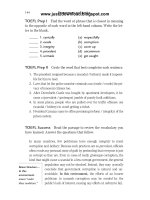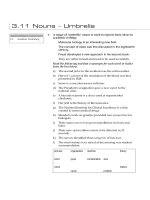Reading comprehension success part 17 pdf
Bạn đang xem bản rút gọn của tài liệu. Xem và tải ngay bản đầy đủ của tài liệu tại đây (82.63 KB, 10 trang )
How did you do? If you got all of the answers
correct, congratulations! Good work. If you missed a
few, you might want to take time to review the corre-
sponding lessons.
IF YOU MISSED: THEN STUDY:
Question 1 Lesson 1
Question 2 Lesson 1
Question 3 Lesson 4
Question 4 Lesson 4
Question 5 Lessons 6–10
Question 6 Lesson 11
Question 7 Lesson 11
Question 8 Lesson 12
Question 9 Lesson 14
Question 10 Lessons 16 and 17
Question 11 Lesson 3
Question 12 Lesson 18
Question 13 Lessons 2 and 16
Congratulations!
You’ve completed 20 lessons and have seen your
reading skills increase. If you’re preparing for a stan-
dardized test, you should check out Appendix A, which
provides tips on how to prepare and what to do during
the test. And don’t forget Appendix B, which gives sug-
gestions for how to continue to improve your reading
skills, along with a list of suggested books organized by
subject categories.
Now it’s time to reward yourself for a job well
done. Buy yourself a good book and enjoy!
– DRAWING CONCLUSIONS: PUTTING IT ALL TOGETHER–
147
ow that you’ve spent a good deal of time improving your reading comprehension, take this
posttest to see how much you’ve learned. If you took the pretest at the beginning of this book, you
can compare what you knew when you started the book with what you know now.
When you complete this test, grade yourself, and then compare your score with your score on the pretest.
If your score now is much greater than your pretest score, congratulations—you’ve profited noticeably from your
hard work. If your score shows little improvement, perhaps you need to review certain chapters. Do you notice a
pattern to the types of questions you got wrong? Whatever you score on this posttest, keep this book around for
review and refer to it when you need tips on how to read more efficiently.
Use the answer sheet on the next page to fill in the correct answers. Or, if you prefer, simply circle the answer
numbers in this book. If the book doesn’t belong to you, write the numbers 1–50 on a piece of paper and record
your answers there. Take as much time as you need to do this short test. When you finish, check your answers against
the answer key that follows. Each answer tells you which lesson of this book teaches you about the reading strat-
egy in that question.
Posttest
149
2. abcd
3. abcd
4. abcd
5. abcd
6. abcd
7. abcd
8. abcd
9. abcd
10. abcd
11. abcd
12. abcd
13. abcd
14. abcd
15. abcd
16. abcd
17. abcd
18. abcd
19. abcd
20. abcd
21. abcd
22. abcd
23. abcd
24. abcd
25. abcd
26. abcd
27. abcd
28. abcd
29. abcd
30. abcd
31. abcd
32. abcd
33. abcd
34. abcd
35. abcd
36. abcd
37. abcd
38. abcd
39. abcd
40. abcd
41. abcd
42. abcd
43. abcd
44. abcd
45. abcd
46. abcd
47. abcd
48. abcd
49. abcd
50. abcd
– LEARNINGEXPRESS ANSWER SHEET–
151
Posttest
The posttest consists of a series of reading passages with questions that follow to test your comprehension.
– POSTTEST–
153
Grunge Music and American Popular Culture
The late 1980s found the landscape of popular music in America dominated by a distinctive style of rock and roll
known as Glam Rock or Hair Metal—so called because of the over-styled hair, makeup, and wardrobe worn by
the genre’s ostentatious rockers. Bands like Poison, Whitesnake, and Mötley Crüe popularized glam rock with their
power ballads and flashy style, but the product had worn thin by the early 1990s. Just as superficial as the 80s, glam
rockers were shallow, short on substance, and musically inferior.
In 1991, a Seattle-based band called Nirvana shocked the corporate music industry with the release of its debut
single, “Smells Like Teen Spirit,” which quickly became a huge hit all over the world. Nirvana’s distorted, guitar-
laden sound and thought-provoking lyrics were the antithesis of glam rock, and the youth of America were quick
to pledge their allegiance to the brand-new movement known as grunge.
Grunge actually got its start in the Pacific Northwest during the mid-1980s. Nirvana had simply main-
streamed a sound and culture that got its start years before with bands like Mudhoney, Soundgarden, and Green
River. Grunge rockers derived their fashion sense from the youth culture of the Pacific Northwest: a melding of punk
rock style and outdoors clothing like flannels, heavy boots, worn out jeans, and corduroys. At the height of the move-
ment’s popularity, when other Seattle bands like Pearl Jam and Alice in Chains were all the rage, the trappings of
grunge were working their way to the height of American fashion. Like the music, the teenagers were fast to
embrace the grunge fashion because it represented defiance against corporate America and shallow pop culture.
The popularity of grunge music was ephemeral; by the mid- to late-1990s, its influence upon American cul-
ture had all but disappeared, and most of its recognizable bands were nowhere to be seen on the charts. The heavy
sound and themes of grunge were replaced on the radio waves by boy bands like the Backstreet Boys, and the
bubblegum pop of Britney Spears and Christina Aguilera.
There are many reasons why the Seattle sound faded out of the mainstream as quickly as it rocketed to promi-
nence, but the most glaring reason lies at the defiant, anti-establishment heart of the grunge movement itself. It
is very hard to buck the trend when you are the one setting it, and many of the grunge bands were never com-
fortable with the fame that was thrust upon them. Ultimately, the simple fact that many grunge bands were so
against mainstream rock stardom eventually took the movement back to where it started: underground. The fickle
American mainstream public, as quick as they were to hop on to the grunge bandwagon, were just as quick to hop
off and move on to something else.
1. The word “ostentatious” in the first sentence
most nearly means
a. stubborn.
b. youthful.
c. showy.
d. unadorned.
2. Teenagers embraced grunge fashion because
a. they were tired of Glam Rock fashion.
b. it defied corporate America and the shallow-
ness of pop culture.
c. grunge rockers told them to embrace it.
d. it outraged their parents.
3.
By stating that “glam rockers were shallow, short
on substance, and musically inferior,”this author is
a. using a time-honored form of reporting that
dignifies his or her position.
b. resorting to a subjective, emotional assertion
that is not an effective way to build an
argument.
c. making an objective, logical assertion based
on facts.
d. merely quoting what others say about glam
rock and detaching her- or himself from the
opinion.
4. This writer is trying to document
a. the popularity of glam rock.
b. Nirvana’s role in popularizing grunge music.
c. the rise and fall of grunge music.
d. the reasons young people responded so enthu-
siastically to grunge music.
5. According to this passage, what is the difference
between glam rock and grunge?
a. Glam rock is flashier and superficial, while
grunge is thought-provoking and anti-
establishment.
b. Glam rock appeals to teenagers, while grunge
appeals to adults.
c. Glam rock faded quickly, while grunge is still
prominent.
d. Glam rock was more commercially successful
than grunge.
6. The tone of the sentence, “The fickle American
mainstream public, as quick as they were to hop
on to the grunge bandwagon, were just as quick
to hop off and move on to something else” can
be best described as
a. authoritative.
b. gloomy.
c. cynical.
d. ironic.
7. Which of the following bands is not associated
with grunge?
a. Nirvana
b. Mudhoney
c. Pearl Jam
d. Backstreet Boys
– POSTTEST–
154
To Lease or Not to Lease
Planning to lease a car because you don’t think you can afford to buy? Think again. Leasing can end up being just
as expensive as buying—and you don’t even get to the keep the car. Most people who are thinking about leasing
are attracted to this option because they believe it will cost them less money. And they’re right—it is cheaper, but
only in the short term. For example, if you were to lease a brand-new Subaru Forester with $4,000 down, you might
pay $300 per month for the car. If you were to buy the same car with $3,000 down, you would pay closer to $400
per month. Over a three-year lease, that’s $3,600—a big savings. But after your lease is over, you have to give the
car back. If you want to keep driving, you’ll either have to put another down-payment on another lease, or, if you
have the option to buy the car, you’ll have to pay thousands of dollars to purchase the vehicle—dollars that won’t
be spread out in more manageable monthly payments.
Many people want to lease because they can drive a more upmarket car than they might otherwise be able
to afford. For example, if your monthly budget allowed you to spend $300 on a car, you might be able to lease a
brand new Ford Explorer. For the same price, you might have to buy an Explorer that was two or three years old
with 50,000 miles, or buy a new but considerably less expensive make and model. A lease, therefore, allows you
to drive the latest models of more expensive cars. But when your lease is over, you will have to return that
Explorer. Whatever car you can afford to buy, you get to keep it, and it will always have a resell or trade-in value
if you want to later upgrade to a newer car.
Furthermore, people who lease cars are often shocked and appalled by how much they must pay when the
lease is over. Most leases limit you to a certain number of miles, and if you go over that allotment, you must pay
for each mile. As a result, at the end of a lease, you may end up paying thousands of dollars in mileage fees. For
example, if your lease covers you for 25,000 miles over three years, but you drive 40,000, that’s an extra 15,000 miles.
At $.11 per mile, that’s $1,650 you’ll have to pay. And you still won’t have a car.
In addition, when you lease, you still have to pay for regular maintenance and repairs to the vehicle. Since
you must return the car when your lease expires, you are paying to repair someone else’s car. If you own the car,
however, you would know that every dollar you spend maintaining or repairing the car is an investment in a real
piece of property—your property, not someone else’s.
By now, the benefits of buying over leasing should be clear. But if you’re still not convinced, remember this
fundamental fact: If you lease, when your lease is up, and after you’ve made all of your monthly payments, paid
for extra mileage, and paid for repairs, you must give the car back. It isn’t yours to keep, no matter how much the
lease cost you. Whatever make or model you can afford to buy, it is yours to keep after you make the payments.
There’s no giving it back, and that makes all the difference.
– POSTTEST–
155
8. According to the passage, which of the following
statements is true?
a. People believe leasing will cost them less
money.
b. Most Americans lease rather than buy cars.
c. Most car leases allow for unlimited mileage.
d. Leasing a car is never as expensive as buying.
9. Which of the following sentences best summa-
rizes the main idea of this passage?
a. Leasing a car is a bad idea.
b. The benefits of buying a car outweigh the ben-
efits of leasing a car.
c.
Leasing allows people to drive more expensive
cars than they might otherwise be able to afford.
d. People are often shocked at how much money
they end up paying when a car lease is over.
10. The author makes his or her point by
a. making an argument using chronological
order.
b. arguing the benefits of buying from the most
to least important.
c. comparing and contrasting leasing and buying.
d. stating opinions.
11.
This writer bases his or her argument primarily on
a. facts derived from the author’s personal
observations.
b. opinions that others have reported to the
author.
c. facts with logic and statistics supporting them.
d. opinions derived from the author’s personal
observations.
12. In another version of this passage, the first sen-
tence of the third paragraph did not use the
words “shocked and appalled” to describe the
reaction of car leasers to how much money they
must pay when the lease is over. Instead, the sen-
tence read: “Furthermore, people who lease cars
are usually unaware of how much they must pay
when the lease is over.” Why do you think the
writer changed the sentence to include “shocked
and appalled”?
a. Someone he or she interviewed for the story
used these words.
b. These words make the author sound smarter.
c. These words have a positive connotation that
help the author make his or her case.
d. These words have a powerful negative conno-
tation that add to the author’s arguments
about the downfalls of leasing.
13. From the context, it can be determined that the
word “upmarket” in the third paragraph means
a. safer.
b. bigger.
c. expensive.
d. dependable.
14. Why did the author choose the second-person
point of view for this passage?
a. The second-person point of view puts readers
into the action of the writing.
b. The second-person point of view makes
readers imagine themselves in the situation.
c. The second-person point of view makes
readers pay more attention.
d. all of the above
15. When this author says that “most people want
to lease because they can then drive a more
upmarket car,” he or she is
a. making a generalization that requires evidence
before it can be confirmed.
b. making an obvious generalization that needs
no evidence.
c. reaching an unreasonable conclusion based on
evidence provided.
d. reaching a reasonable conclusion based on
evidence provided.
– POSTTEST–
156









